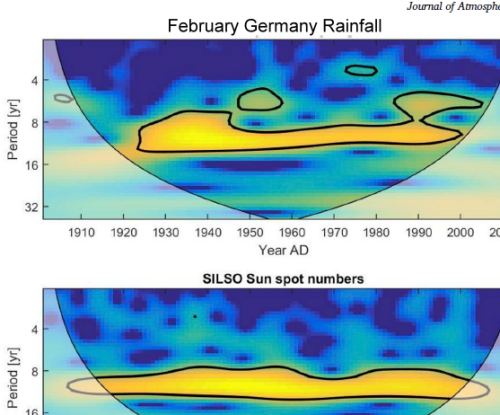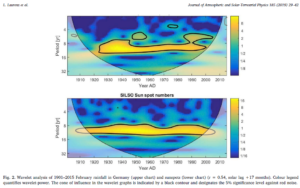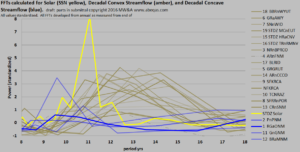I’m pleased to post this information by way of a new acquaintance, Sebastian Lüning (and by extension his co-authors), with whom I’ve had occasional correspondence throughout this year. Between my 2019 paper and theirs featured in this press release, we have many shared interests. Obviously, the importance of a solar driver for hydroclimatology is recognized and highlighted for both papers, even though the study regions vary. Theirs focused on Europe and mine focused on the Southern Rocky Mountains of North America.
And we both have made the exploration of lagged correlations between sunspot numbers and moisture patterns paramount. On the other hand, there are also some important differences in our approaches and the background literature that we explore. I encourage any reader to read both papers and to hopefully develop a better understanding of the potentials and challenges for solar cycle – based moisture forecasting, whether regarding precipitation or streamflows.
I won’t try to exceed their press release extent with this introduction, but I don’t mind a crude comparison between their Figure 2, and a post of mine. Both approaches, even though based on information from different hemispheres and moisture indexes (one is precipitation, the other is streamflow), arrive at a similar distribution of cycle periods that hover around the 11-year contemporary solar cycle pattern.
First, I cite “fair use” to enter this reproduction of their wavelet exercise figure which focuses on a 1901–2015 February rainfall in Germany comparison to the solar cycle (https://ars.els-cdn.com/content/image/1-s2.0-S1364682618305273-gr2.sml):
Next I don’t need any further permission to reproduce this image from a past post of mine, which focuses on cycles derived by simple FFT exercises for streams of the Southern Rockies:
Without further spinning from me, here is their press release.
Press Release
Institute of Hydrography, Geoecology and Climate Sciences (IFHGK), www.ifhgk.org
15th February 2019
Influence of solar activity on European rainfall
By Laurenz, L., H.-J. Lüdecke, and S. Lüning
A balanced level of precipitation provides the basis for a wide range of economic and social activities in Europe. Particularly agriculture, drinking water supply and inland waterway transport are directly affected. However, the amount of rain fluctuates strongly from year to year. While it may pour torrentially in one year, rain may remain absent for weeks in another year. The population is used to this variability and knows how to deal with it.
The chance discovery by an agricultural scientist from Münster, Germany, now suggests that in certain months rain over Germany and other parts of Europe follows a pattern that up to now has remained undetected. As part of agricultural consultation, Ludger Laurenz analyzed decades of rainfall records of his home weather station in Münster and noticed a constant up and down that followed an 11-year rhythm – especially in February. After detailed examination it was clear that this rhythm correlated closely with the activity of the sun: the well-documented 11-year sunspot cycle.
Laurenz next teamed up with two colleagues to examine the extent to which the observed pattern from Münster is reproducible in other parts of Germany and Europe, and whether the phenomenon also exists for the other months of the year. Horst-Joachim Lüdecke from the HTW University of Applied Sciences in Saarland gathered the precipitation data collected in Europe since the beginning of the 20th century. The physicist emeritus then developed a computer algorithm to determine the similarity of changes in rainfall and solar activity. All 39 European countries and every one of the 12 months of the year were quantified over a total of 115 years using mathematical correlations.
In order to include possible delay effects, the data series of rain and sunspots were systematically checked for shifts. For this purpose, the time series were gradually shifted in time against each other like combs and the respective change of the correlation quality was noted. The multidimensional data obtained in this way were evaluated for systematic trends by geoscientist Sebastian Lüning and visualized cartographically. Lüning is associated with the Swiss Institute of Hydrography, Geoecology and Climate Sciences (IFHGK) and is specialized in the research of solar climate effects.
The mapped out results show that the link between February precipitation and solar activity originally discovered in Münster is valid for large parts of Central and Northern Europe and has good statistical significance there. Towards southern Europe, however, the correlation weakens significantly.
The statistical investigation was also able to demonstrate systematic phase shifts across the continent. In Germany and neighboring countries, February precipitation was particularly low when the sun was very strong four years earlier. The delay seems to be due to the slow deep circulation of the Atlantic, as earlier work had already suggested. On the basis of the statistically-empirically determined correlation, February 2018 in Germany with particularly low precipitation can now also be explained, which followed a particularly high intensity peak of solar activity at the beginning of 2014.
Similar relationships between rainfall and solar activity have been observed in other months, although somewhat weaker, especially in April, June and July, which account for a large part of the vegetation period in Central Europe. The result was a complex interplay of sun and rain in Europe, which showed clear trends over 1000 km and varied strongly from month to month.
The study thus confirms the concept of a solar participation in the European hydroclimatic development, which had already been indicated by a whole series of local case studies of other authors. The exact mechanism by which the solar signal influences precipitation is still largely unclear and requires further research.
The solar precipitation effect now mapped out across Europe for the first time opens up new possibilities for improved medium-term precipitation forecasts. Agriculture in particular, but also protection measures against extreme weather damage in connection with heavy rainfall and droughts could benefit from this. The next step in refining the forecasting methodology is a more precise quantification of the effects of Atlantic Ocean cycles, which also play an important role in rainfall, especially in Western Europe.
Original publication:
Laurenz, L., H.-J. Lüdecke, S. Lüning (2019): Influence of solar activity on European rainfall. J. Atmospheric and Solar-Terrestrial Physics, 185: 29-42, doi: 10.1016/j.jastp.2019.01.012
The pdf version can be downloaded free of charge at the following link until early March: https://authors.elsevier.com/a/1YXWZ4sIlkiVhv
 6902total visits,3visits today
6902total visits,3visits today


